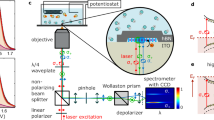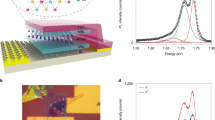Abstract
Breaking space–time symmetries in two-dimensional crystals can markedly influence their macroscopic electronic properties. Monolayer transition metal dichalcogenides (TMDs) are prime examples where the intrinsically broken crystal inversion symmetry permits the generation of valley-selective electron populations1,2,3,4, even though the two valleys are energetically degenerate, locked by time-reversal symmetry. Lifting the valley degeneracy in these materials is of great interest because it would allow for valley-specific band engineering and offer additional control in valleytronic applications. Although applying a magnetic field should, in principle, accomplish this task, experiments so far have not shown valley-selective energy level shifts in fields accessible in the laboratory. Here, we show the first direct evidence of lifted valley degeneracy in the monolayer TMD WS2. By applying intense circularly polarized light, which breaks time-reversal symmetry, we demonstrate that the exciton level in each valley can be selectively tuned by as much as 18 meV through the optical Stark effect. These results offer a new way to control the valley degree of freedom, and may provide a means to realize new Floquet topological phases5,6,7 in two-dimensional TMDs.
This is a preview of subscription content, access via your institution
Access options
Subscribe to this journal
Receive 12 print issues and online access
$259.00 per year
only $21.58 per issue
Buy this article
- Purchase on Springer Link
- Instant access to full article PDF
Prices may be subject to local taxes which are calculated during checkout




Similar content being viewed by others
References
Xiao, D., Liu, G-B., Feng, W., Xu, X. & Yao, W. Coupled spin and valley physics in monolayers of MoS2 and other group-VI dichalcogenides. Phys. Rev. Lett. 108, 196802 (2012).
Mak, K. F., He, K., Shan, J. & Heinz, T. F. Control of valley polarization in monolayer MoS2 by optical helicity. Nature Nanotech. 7, 494–498 (2012).
Zeng, H., Dai, J., Yao, W., Xiao, D. & Cui, X. Valley polarization in MoS2 monolayers by optical pumping. Nature Nanotech. 7, 490–493 (2012).
Cao, T. et al. Valley-selective circular dichroism of monolayer molybdenum disulphide. Nature Commun. 3, 887 (2012).
Inoue, J. & Tanaka, A. Photoinduced transition between conventional and topological insulators in two-dimensional electronic systems. Phys. Rev. Lett. 105, 017401 (2010).
Kitagawa, T., Oka, T., Brataas, A., Fu, L. & Demler, E. Transport properties of nonequilibrium systems under the application of light: Photoinduced quantum Hall insulators without Landau levels. Phys. Rev. B 84, 235108 (2011).
Lindner, N. H., Refael, G. & Galitski, V. Floquet topological insulator in semiconductor quantum wells. Nature Phys. 7, 490–495 (2011).
Shirley, J. H. Solution of Schrodinger equation with a Hamiltonian periodic in time. Phys. Rev. 138, B979–B987 (1965).
Autler, S. H. & Townes, C. H. Stark effect in rapidly varying fields. Phys. Rev. 100, 703–722 (1955).
Bakos, J. S. AC Stark effect and multiphoton processes in atoms. Phys. Rep. 31, 209–235 (1977).
Cohen-Tannoudji, C. N. & Phillips, W. D. New mechanisms for laser cooling. Phys. Today 43, 33–40 (1990).
Wang, Y. H., Steinberg, H., Jarillo-Herrero, P. & Gedik, N. Observation of Floquet–Bloch states on the surface of a topological insulator. Science 342, 453–457 (2013).
Joffre, M., Hulin, D., Migus, A. & Antonetti, A. Dynamics of the optical Stark effect in semiconductors. J. Mod. Opt. 35, 1951–1964 (1988).
Fröhlich, D., Nöthe, A. & Reimann, K. Observation of the resonant optical Stark effect in a semiconductor. Phys. Rev. Lett. 55, 1335–1337 (1985).
Mysyrowicz, A. et al. “Dressed excitons” in a multiple-quantum-well structure: Evidence for an optical Stark effect with femtosecond response time. Phys. Rev. Lett. 56, 2748–2751 (1986).
Chemla, D. S. et al. The excitonic optical Stark effect in semiconductor quantum wells probed with femtosecond optical pulses. J. Lumin. 44, 233–246 (1989).
Sieh, C. et al. Coulomb memory signatures in the excitonic optical Stark effect. Phys. Rev. Lett. 82, 3112–3115 (1999).
Hayat, A. et al. Dynamic Stark effect in strongly coupled microcavity exciton polaritons. Phys. Rev. Lett. 109, 033605 (2012).
Koster, N. S. et al. Giant dynamical Stark shift in germanium quantum wells. Appl. Phys. Lett. 98, 161103 (2011).
Sie, E. J., Lee, Y-H., Frenzel, A. J., Kong, J. & Gedik, N. Biexciton formation in monolayer MoS2 observed by transient absorption spectroscopy. Preprint at http://arxiv.org/abs/1312.2918 (2013)
Combescot, M. Optical Stark effect of the exciton. II. Polarization effects and exciton splitting. Phys. Rev. B 41, 3517–3533 (1990).
Bernevig, B. A., Hughes, T. L. & Zhang, S. C. Quantum spin Hall effect and topological phase transition in HgTe quantum wells. Science 314, 1757–1761 (2006).
Perez-Piskunow, P. M., Usaj, G., Balseiro, C. A. & Torres, L. E. F. F. Floquet chiral edge states in graphene. Phys. Rev. B 89, 121401(R) (2014).
Liu, X. et al. Strong light–matter coupling in two-dimensional atomic crystals. Preprint at http://arxiv.org/abs/1406.4826 (2014)
Mai, C. et al. Many-body effects in valleytronics: Direct measurement of valley lifetimes in single-layer MoS2 . Nano Lett. 14, 202–206 (2014).
Mai, C. et al. Exciton valley relaxation in a single layer of WS2 measured by ultrafast spectroscopy. Phys. Rev. B 90, 041414(R) (2014).
Kim, J. et al. Ultrafast generation of pseudo-magnetic field for valley exciton in WSe2 monolayers. Preprint at http://arxiv.org/abs/1407.2347 (2014)
MacNeill, D. et al. Valley degeneracy breaking by magnetic field in monolayer MoSe2. Preprint at http://arxiv.org/abs/1407.0686 (2014)
Aivazian, G. et al. Magnetic control of valley pseudospin in monolayer WSe2. Preprint at http://arxiv.org/abs/1407.2645 (2014)
Srivastava, A. et al. Valley Zeeman effect in elementary optical excitations of a monolayer WSe2. Preprint at http://arxiv.org/abs/1407.2624 (2014)
Li, Y. et al. Valley splitting and polarization by the Zeeman effect in monolayer MoSe2. Preprint at http://arxiv.org/abs/1409.8538 (2014)
Lee, Y-H. et al. Synthesis of large-area MoS2 atomic layers with chemical vapor deposition. Adv. Mater. 24, 2320–2325 (2012).
Lee, Y-H. et al. Synthesis and transfer of single-layer transition metal disulfides on diverse surfaces. Nano Lett. 13, 1852–1857 (2013).
Gutiérrez, H. R. et al. Extraordinary room-temperature photoluminescence in triangular WS2 monolayers. Nano Lett. 13, 3447–3454 (2012).
Acknowledgements
The authors acknowledge technical assistance from Q. Ma and Y. Bie during the measurement of the equilibrium absorption of monolayer WS2, and helpful discussions with Z. Alpichshev, I. M. Vishik and Y. H. Wang. This work is supported by US Department of Energy (DOE) award numbers DE-FG02-08ER46521 and DE-SC0006423 (data acquisition and analysis). Y-H.L. and J.K. acknowledge support from NSF DMR 0845358 (material growth and characterization). Y-H.L. also acknowledges partial support from the Ministry of Science and Technology of the Republic of China (103-2112-M-007-001-MY3). L.F. acknowledges support from the STC Center for Integrated Quantum Materials (CIQM), NSF Grant No. DMR-1231319 (theory).
Author information
Authors and Affiliations
Contributions
E.J.S. performed the experiments and the data analysis, and wrote the manuscript with crucial inputs from J.W.M., L.F. and N.G. The Floquet topological phase in TMDs was initially proposed by L.F. The monolayers of WS2 were synthesized by Y-H.L., supervised by J.K. This project is supervised by N.G.
Corresponding author
Ethics declarations
Competing interests
The authors declare no competing financial interests.
Supplementary information
Supplementary Information
Supplementary Information (PDF 1198 kb)
Rights and permissions
About this article
Cite this article
Sie, E., McIver, J., Lee, YH. et al. Valley-selective optical Stark effect in monolayer WS2. Nature Mater 14, 290–294 (2015). https://doi.org/10.1038/nmat4156
Received:
Accepted:
Published:
Issue Date:
DOI: https://doi.org/10.1038/nmat4156
This article is cited by
-
Exploring modern developments in diverse 2D photocatalysts for water oxidation
Journal of Porous Materials (2024)
-
Excitonic devices based on two-dimensional transition metal dichalcogenides van der Waals heterostructures
Frontiers of Chemical Science and Engineering (2024)
-
Pseudospin-selective Floquet band engineering in black phosphorus
Nature (2023)
-
Optically induced resonant tunneling of electrons in nanostructures
Scientific Reports (2023)
-
Versatile optical manipulation of trions, dark excitons and biexcitons through contrasting exciton-photon coupling
Light: Science & Applications (2023)



